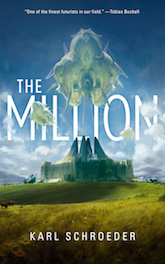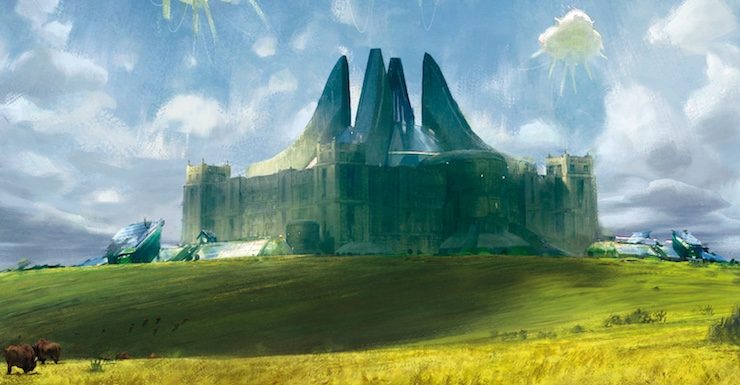At one point in my new novella The Million, our hero Gavin is crossing Europe by airship. Gazing out the windows, he sees this:
There were no settlements. Elephants, boars, lions, and the ancient bull of legend, the aurochs, wandered at will. Now and then the zeppelin would pass one of the museum cities. Often, nothing remained but the cathedrals, which had been built to last. Some cities had been tended well, and thousands of years of architectural glory were on display, all of it lovingly tended by the bots that walked their plazas and alleys.
Dusk chased the sun into France and Iberia, and the Alps rolled by. Their peaks were the last to catch the light, and the mountaintops blazed like a thousand bonfires for a few minutes before night fell entirely. Now the land below was invisible, cloaked in a blackness it had not seen while the cities had been inhabited. The sky blazed with stars and the Milky Way bannered across them like a conqueror’s flag.
It’s an empty world. But The Million is not a post-apocalyptic dystopia. On the contrary, The Million could be our best hope, and the Earth’s.
There’s a term that futurists use: “the default future.” The default future is what we assume is going to happen, as a matter of obvious fact. Its assumptions are so deeply ingrained that we don’t even know they’re there. For instance, current popular culture typically imagines one of just three possible future Earths: an Orwellian dystopia, a post-apocalyptic wasteland, or a space-faring urban hypercivilization. It seems to be really hard for people to think out of this particular box; the default future of the 1960s was exactly what Gene Rodenberry wanted to challenge when he crafted Star Trek’s future as post-scarcity, post-racist and post-war. At the time, many people were shocked and even outraged at his vision.
I’m as prone to thinking in defaults as anyone; I set Lady of Mazes in a settled Solar system that has a population of seventy billion people—a pretty standard “Tomorrowland” scenario. That made for some great worldbuilding, but at some point, while writing the book, I began to wonder what all those seventy trillion were for:
“You’re wallpaper, Ishani,” said Charon. “You can’t have a thought that a million other people aren’t having, you can’t do anything that a million other people aren’t also doing. It doesn’t matter what you say or whether you live or die because a million other you’s are there to take your place. So why should I care what you do to me? You’re wallpaper.”
I began to realize that I was living in a labyrinth without exits. You see that you have a choice: either exist as wallpaper, and accept that there’s nothing you can do that hasn’t been done before, nothing you can say that hasn’t been said, nothing you can think that a million others aren’t thinking right this second… or else, allow inscape to craft some unique, fulfilling, and utterly unreal fantasy world for you to live in. Any attempt to fight the system becomes part of the system. There is no escape.
One day I thought: why should humanity expand limitlessly? Why not go the other way? …And so, I stumbled out of my own default future.
Buy the Book


The Million
In The Million, there are only one million people on Earth; only one million are allowed. This small population has inherited all of humanity’s wealth, history, art and riches. What this means is that the museum cities that Gavin passes over aren’t entirely empty; they are family homes, and the regions he passes—Brittany, Burgundy, Champagne; Fribourg, Lucerne, Bavaria—these are people’s yards.
This might all sound crazy, but I submit that it only seems that way because it’s the opposite of our default future. We assume that prosperity, success, and sustainability are tied directly to growth—of physical wealth, of our mastery of nature, of knowledge and technology—but also growth in population. There was probably a time when this was true: for the struggling empires of the nineteenth century, population was power. At this very moment, it’s probably also true; but is it going to continue to be, even in the near future of our own lifetimes?
Automation is maintaining our quality of life while reducing the need for human labor. Meanwhile, it seems that family sizes naturally decline when women are educated and in control of their own fertility, and people’s nutrition and health care are taken care of. In fact, we’ve got a pretty good idea of the maximum number of humans that will ever simultaneously live on this planet, and it’s not much more than we’ve got now. Walter Greiling projected 9 billion back in the 1950s, and recent projections are similar. Our cities are getting more crowded, but it’s because more people are moving into them, not because there are that many more people. Two billion will join us before the mid-point of the century, and then, we level off.
But should we? Sharing the wealth among nine billion will be hard. In many nations, birth-rates are on the decline. Shouldn’t we encourage that trend?
Here’s a proposal: let’s get smaller. Imagine a future where the economy is increasingly automated and taps into the infinite resources of outer space; and where humanity shares a core of common goods such as Universal Basic Income, Universal Healthcare, and free education. These aren’t fantasies, they’re trends. Now add to this mix a naturally declining population that retains its genetic diversity. The formula for our future becomes: more and more wealth, divided among fewer and fewer people.
In material terms alone, the results are staggering. Imagine if your family owned Paris? Or was responsible for tending the Catskill Mountains? What does wealth mean when robotics, automation and AI mean that each person can have, not money or an income, but his or her own economy? When kids learn history by reenacting the Battle of the Somme with real robot armies? When you don’t watch movies, you have the entire story including sets, car chases and crowd scenes, played out for you by troops of android players?
For some people, whether this is a Utopia or nightmare scenario depends entirely on whether Earth’s remaining million are people they’d approve of. Some cling to the belief that humanity is fighting a titanic struggle, a zero-sum war between civilizations, cultures, races or religions. The Million will be paradise if Our Guys are the only ones left standing, but Hell if it’s the Other Guys.
A funny thing happens, though, when you imagine shrinking our population down like this—to a billion, a million, or even further (though I didn’t call the story The Thousand, that possibility did cross my mind). As our numbers decrease, the value of our diversity increases. The Million is a lens through which we can see ever more clearly, and regret even more, the crimes our ancestors committed in wiping out entire civilizations. The libraries of Alexandria and of the Mayans were burned; thousands of languages have gone extinct, taking with them millennia of wisdom. How much art and music have we expunged over the ages? And if we were to continue? It could all go, save for the bland entertainments of that tiny leftover, a rump human race blinking stupidly in the ruins.
Or, it could go another way.
When you play the game of reducing humanity, the obvious question becomes what quantity do you stop at, and why? What’s the smallest viable future human population? The lower limit isn’t set by population genetics (because we can now bank our DNA to guarantee a pool of diversity), nor by any threat of extinction (because for every credible threat, a rich technological civilization can design a countermeasure). I see two criteria that can help us set the limit; both are interesting, and surprisingly Utopian.
First, as E.O. Wilson has pointed out in his powerful book Half-Earth: Our Planet’s Fight for Life, our current civilization has wildly overrun our planet’s ecological carrying capacity. We could indulge a post-scarcity fantasy and propose an Earth with billions of people on it who live in a regreened natural world. But we’d have to explain how Earth can be post-scarcity for the trees, grasslands, and animals while we’re still sprawled all over the real estate. Wilson’s solution is to give half the planet back to nature; it’s hard to imagine how to do this without crowding all of us into some kind of planetary ghetto. Reducing our population works better for everybody.
Secondly, there’s that matter of the zero-sum game. The model of civilizational warfare makes no sense if you consider all of our human accomplishments to be treasures. The rope bridges of the Inca and the Egyptian pyramids, the story cycles of the Haida and the paintings of Rembrandt—they’re all part of humanity’s inheritance. The Million could be the inheritors.
How few people does it take to appreciate and keep alive the full splendor of human achievement?—our languages, cultures, artistic and dramatic forms, and knowledge? There’s more than one way to be rich, and while our descendants may inherit increasing material wealth with their declining population, they will risk becoming poor in spirit. That’s the danger.
This is why, in The Million, each citizen is expected to do their part to preserve and celebrate humanity’s history and diversity, even while creating new splendors. Who wants to live in a world where everybody looks and thinks the same, sings the same songs, tells the same stories? The Million are a permanent explosion of creativity, all of them mastering old forms while exploring new ones. From dance to dueling, tea ceremony to architecture, everybody does something. In other words, this is not a future of pointless indulgences and decadent indolence. In this world, the value of the individual skyrockets, because each person is responsible for some part of the very real accomplishments of our ancestors, and has a duty to make their own generation meaningful in turn. The Million work very hard, because they have the heritage of our species resting on their shoulders. They haven’t just inherited our wealth, but have taken on the responsibility for justifying its perpetuation.
This, then, is my answer to the default future. I’ve only just started exploring it; many of the questions I’ve asked above get short-shrift in this first novella. But there’ll be more. Now that I’ve glimpsed it, I’m going to write more stories in this universe, just to see what happens.
Of course, nobody owns the future. I hope you’ll go exploring, too.
Karl Schroeder is an author and futurist whose publications include New York Times Notable Book Ventus as well as the critically acclaimed Virga series. His 2014 novel Lockstep is set in the same universe as The Million. Karl lives in Toronto, Ontario with wife, daughter, and several eccentric animals.










